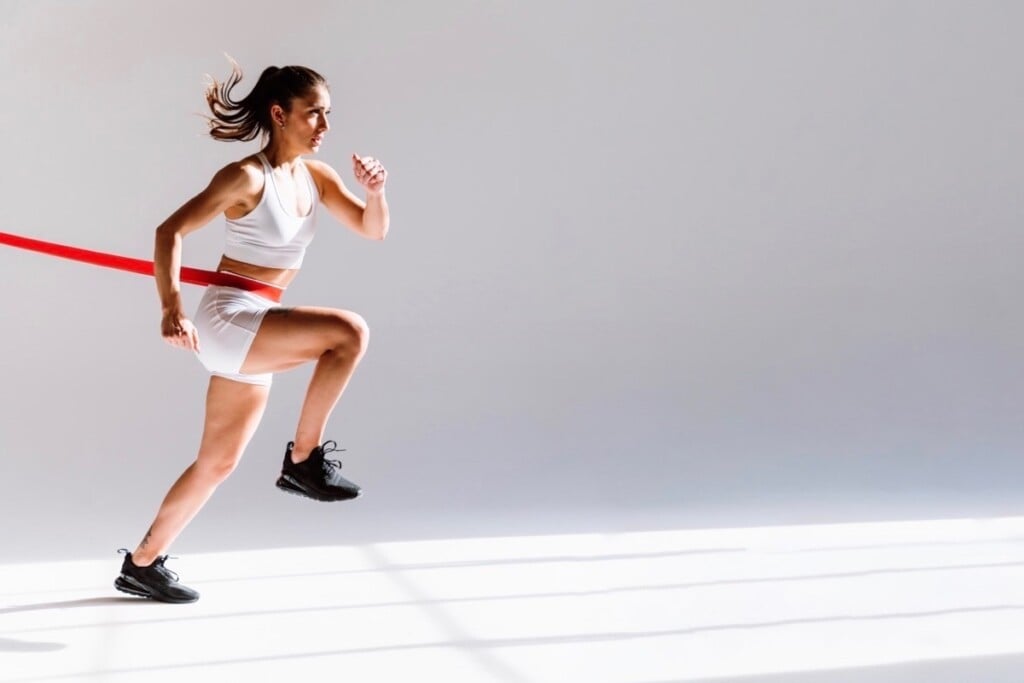The Power Of The Pull
It’s a potent, versatile workout tool that doesn’t require an app: the resistance band.

Leave it to Hollywood and sports A-listers to make a popular new craze out of a simple, low-tech exercise tool that’s been around since the 1800s. Resistance bands trace back to a Swiss inventor who designed a prototype gymnastics apparatus using stretchy ropes with clips and handles. Over the years, the bands have been used by rehabbing patients, gym enthusiasts, home workout fiends—and perhaps the occasional ripped celeb.
Today, basketball uber star LeBron James is known to be “with the band.” When a workout video of him went public in 2013, people saw—between footage of the four-time NBA champion practicing hook shots and three-point jumpers—the way he used resistance bands while performing squats, lunges and other plyometric exercises (that is, those that involve maximum muscle exertion in short bursts of time). More than a decade later, James still reportedly uses resistance-band training as part of his workout regimen, and his physical condition is still apparently pretty good. This past summer, at 39 and the league’s all-time leading scorer, he helped the U.S. men’s basketball team win gold at the Paris Olympics. And he shares the resistance-band habit with actor Jason Momoa, actresses Halle Berry, Jessica Alba and Zendaya and others.
The design of resistance bands has improved over time, as they’ve gone from fabric contraptions to today’s latex-fabric blend, synthetic rubber or silicone. They’re also made with varying levels of tension or resistance, making them ideal for strength training, as they require a person’s force to stretch. (This distinguishes resistance-band training from TRX, or suspension training, which uses a person’s own body weight as resistance.) The Cleveland Clinic reports that a 2019 study shows that training with resistance bands provides strength gains similar to those achieved using conventional gym equipment.
“Some resistance bands are so good that it feels like you’re stretching a truck tire,” says Bill Lutz, a certified personal trainer at Waldwick-based Fitness Performance. Lutz notes that an individual can get a total workout using resistance bands and that they’re “conducive for anyone, from athletes to senior citizens.”
“Instead of racking big, metal plates on a bar to change weight, you simply—and safely—switch bands, which are color-coded based on their resistance,” he explains. “And if you’re traveling, it’s a lot easier to put it in a suitcase. Because bands are so transportable, you’ll never have the excuse that you can’t make it to a gym.”
According to Lutz, who has a master’s degree in sports psychology and more than 30 years’ experience training and coaching, you’ll get the most gains with resistance bands when you focus on technique, allowing muscles to slowly stretch and contract. “I always say to clients, ‘We’re going up in weight’ so they don’t focus on numbers and concentrate on their muscles and the movements.”
Resistance bands aren’t just good for strength training—they’re good for your health too. As muscles strengthen, blood flow and pressure improve in the body, lowering the risk of heart-related ailments such as hypertension and heart disease, according to the American Council on Exercise (ACE). Resistance-band training also burns calories and helps boost the metabolism, both of which can aid weight loss, Lutz notes. However, he says that strength training, including resistance band exercises, should be combined with an appropriate diet if you’re serious about losing weight. “Always consult a doctor or a trained professional before starting, especially if you’re a senior or have been living a sedentary lifestyle,” he advises.
Forget pumping iron—let’s stretch some rubber. Below are four quick, easy resistance-band workouts anyone can try at home. “You can get a lot done in a short workout,” Lutz says. “Longer workouts are not always better. It’s like toast: You can get what you want in a couple of minutes; it doesn’t get better after it’s ‘done.’”
• Clamshells: Lie on your side, one leg on top of the other with your knees slightly bent. Loop a resistance band around both thighs. Keeping your feet together, lift your top knee. Switch sides after each set.
• Chest presses: Wrap the resistance band behind your back, holding both ends with your hands. Starting with your arms at your side and elbows bent, push the band out in front of you as you straighten your elbows, and hold for one second.
• Squats: Stand on the resistance band and grab both ends with your hands. While in a squatting position and holding the band, rise up to a standing position. Lower back down and repeat.
• Rows: Attach the resistance band securely to a door. Holding the band with both hands, pull the band back as you bend your elbows. Keep your elbows near the side of your body.

